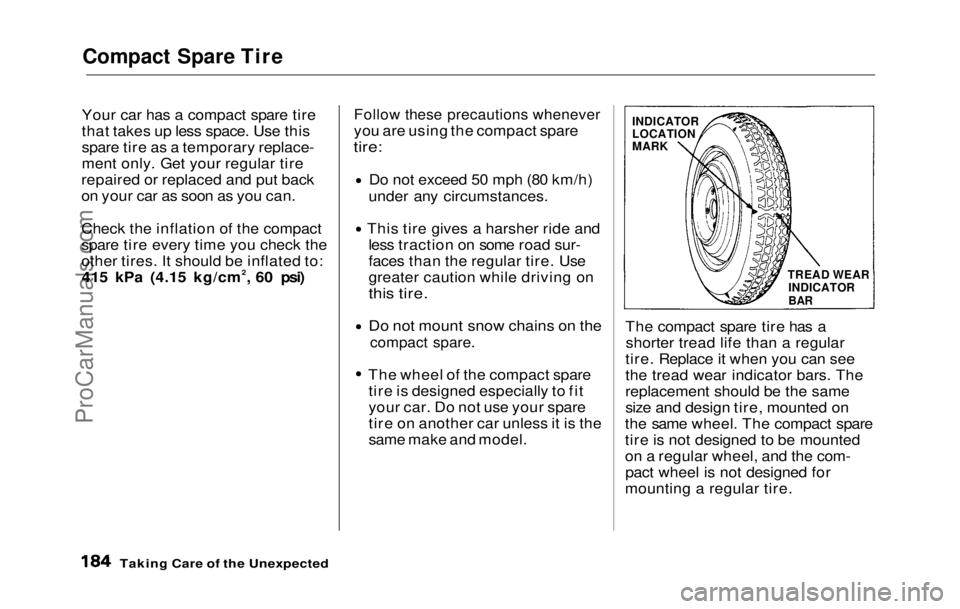ESP HONDA PRELUDE 1992 Owner's Manual
[x] Cancel search | Manufacturer: HONDA, Model Year: 1992, Model line: PRELUDE, Model: HONDA PRELUDE 1992Pages: 225, PDF Size: 2.1 MB
Page 178 of 225

Corrosion Protection, Body Repairs
Inspect and clean out the drain
holes in the bottom of the doors
and body.
Check the floor coverings for
dampness. Carpeting and floor mats may remain damp for a long
time, especially in winter. This dampness can eventually cause
the floor panels to corrode.
Use a high-pressure spray to
clean the underside of your car.
This is especially important in
areas that use road salt in winter. It is also a good idea in humid
climates and areas subject to salt
air. Cars equipped with ABS
have a sensor and wiring at each
wheel. Be careful not to damage
them.
Have the corrosion-preventive
coatings on the underside of your
car inspected and repaired
periodically.
Body Repairs
Body repairs affect your car's
resistance to corrosion. If your car
needs repairs after a collision, pay
close attention to the parts used in
the repair and the quality of the
work.
Make sure the repair facility uses
genuine Honda replacement body
parts. Some companies make
sheetmetal pieces that seem to
duplicate the original Honda body parts, but are actually inferior in fit,
finish, and quality. Once installed,
they do not give the same high- quality appearance and level of
corrosion resistance. When reporting your collision to
the insurance company, tell them
you want genuine Honda parts
used in the repair. Although most insurers recognize the higherquality of original parts, some may
try to specify that the repairs be
done with the "lowest cost" parts
available. You should investigate
this before any repairs are begun.
Take your car to your authorized Honda dealer for inspection after
the repairs are completed. He can make sure that quality materials
were used, and that corrosion-
preventive coatings were applied to
all repaired and replaced parts.
Appearance Car e
ProCarManuals.comMain Menu Table of Contents s t
Page 180 of 225

Compact Spare Tire
Your car has a compact spare tire
that takes up less space. Use this
spare tire as a temporary replace-
ment only. Get your regular tire
repaired or replaced and put back
on your car as soon as you can.
Check the inflation of the compact
spare tire every time you check the
other tires. It should be inflated to: 415 kPa (4.15 kg/cm2, 60 psi)
Follow these precautions whenever
you are using the compact spare
tire:
Do not exceed 50 mph (80 km/h)
under any circumstances. This tire gives a harsher ride and
less traction on some road sur-
faces than the regular tire. Use
greater caution while driving on
this tire.
Do not mount snow chains on the
compact spare.
The wheel
of the compact spare
tire is designed especially to fit
your car. Do not use your spare
tire on another car unless it is the
same make and model. The compact spare tire has a
shorter tread life than a regular
tire. Replace it when you can see
the tread wear indicator bars. The
replacement should be the same
size and design tire, mounted on
the same wheel. The compact spare
tire is not designed to be mounted
on a regular wheel, and the com- pact wheel is not designed for
mounting a regular tire.
Taking Care of the Unexpected
INDICATOR
LOCATION
MARK
TREAD WEARINDICATOR
BARProCarManuals.comMain Menu Table of Contents s t
Page 206 of 225

Four Wheel Steering
The Si 4WS model in the U. S and
the SR 4WS model in Canada are
equipped with an electronic Four
Wheel Steering system.
As inputs, the 4WS system uses a
vehicle speed sensor and a sensor to measure how far the front
wheels are turned.
The electronic control unit for 4WS system uses these inputs to deter-
mine which direction to steer the
rear wheels, and at what angle. Depending on vehicle speed and the
angle of the front wheels, the rear
wheels will be "countersteered"
(steered in the opposite direction of
the front wheels) or "same-steered"
(steered in the same direction as
the front wheels). The 4WS electronic control unit
drives an electric motor built into
the rear steering box. Sensors for
rear wheel angle and speed provide
feedback. The electronic control
unit uses this feedback to compare
the actual rear wheel angle to the
desired angle.
When the driver turns the front
wheels with the car traveling less
than 18 mph (30 km/h), the rear
wheels are countersteered. The angle of countersteer increases as
the angle of the front wheels in-
creases, to a maximum counter-
steer angle of six degrees. This
improves response when parallel
parking or making sharp turns.
Above 18 mph (30 km/h), the rear
wheels are same-steered as the driver begins to turn the steering
wheel. The rear wheel angle for
any given steering wheel angle is
not fixed; it increases as vehicle speed increases. This improves
response in lane-changing maneu-
vers.
As the driver continues to turn the
steering wheel, the rear wheels are
steered back to the straight-ahead
position and then to countersteer
mode. As with same steer, the
angle of countersteer varies with
vehicle speed; increasing and then decreasing as the speed rises. This
gives improved handling in low, medium, and high speed curves.
The 4WS system's electronic
control unit monitors the sensors
whenever the ignition is ON. If it detects a problem anywhere in the
system, it lights the 4WS indicator
on the instrument panel and turns
the system off. With the system off,
the rear wheels remain pointed
straight ahead. Your car will then
drive like a conventional car
without 4WS.
Technical InformationProCarManuals.comMain Menu Table of Contents s t